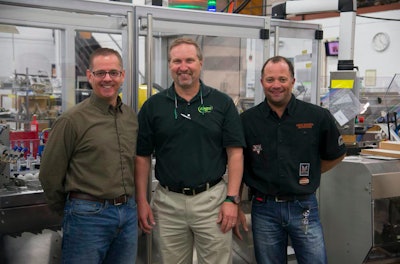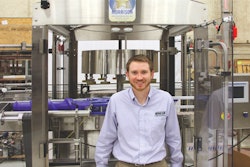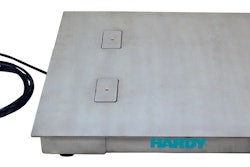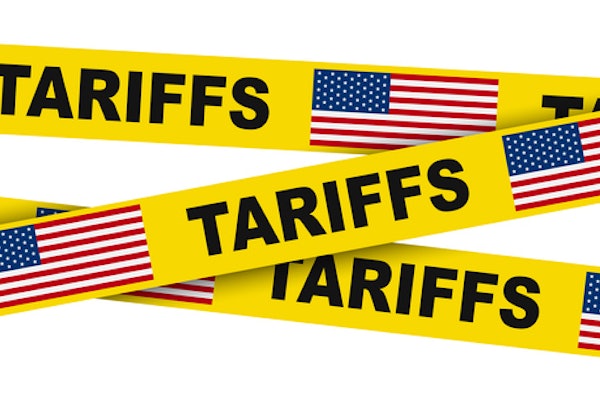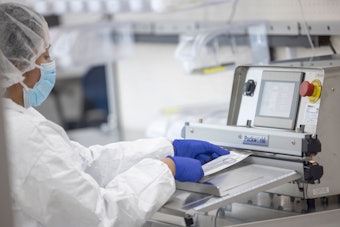Despite consistently engineering and selling major material handling and secondary packaging machine installations to the world’s largest pharmaceutical manufacturers and CMOs, owner and CEO Richard Bahr, says there isn’t a whole lot on the surface that differentiates MGS Machine, Maple Grove, Minn., from many of its build- or engineer-to-order packaging machinery peers and competitors.
“We do great work, but what you’ll see here, just by looking around, is pretty standard,” Bahr says, not one to boast. Maybe that’s just a bit of upper Midwestern humility.
The facilities incorporate the expected doses of lean techniques, CIP, cellular manufacturing, and an adherence to GMP standards that you’d hope to see in manufacturing facility with a pharma-heavy clientele. But Bahr considers such techniques to be merely tools in his larger problem-solving kit.
“A lot of OEMs use those tools,” Bahr says. “But then again, we don’t have a lean guru wandering around, looking for problems to solve, and asking, ‘What do you want me to fix today?’”
Still, as an entrepreneur at the helm of a 100-plus team with between $20 and $50 million in revenue depending on the year, there is no shortage of problems, each begging for attention. Again, MGS isn’t unique among OEMs in this respect.

But, Bahr might be unique in his ability to deal with problems, unearth invisible land mines, ignore non-issues, and prioritize and correct real threats. This is because among his more ubiquitous problem solving tools, Bahr employs a set of techniques found in the book Traction: Get a Grip on Your Business, by Gino Wickman, which addresses the bigger question business leaders often face: Which problems to solve, which to delegate, which to ignore, and all in what order?
Traction approach to all elements of business
“Traction helps close that gap between what you know, and what you do,” Bahr says. “In the years that I’ve been connected with other OEM companies via PMMI, we’ve shared our issues and problems. If there’s a single pervasive problem with companies of our size, it’s that though most of the people running them are smart and well intended, we don’t necessarily do all the things that we know we should do.”
Within the Traction framework, two of the key roles are the visionary and the integrator. The visionary is the person looking past the hood ornament and plotting the organization’s big picture course. Bahr naturally fell into that role. He needed a
partner in crime to implement the program, and guarantee buy-in down the chain. After some convincing and an “a-ha” moment, Mike Verdon, VP, operations, filled the integrator role.
Traction aims to align company values and goals so as to build consensus, engender common purpose among the team, and clarify/simplify strategic planning. The system acts as a framework upon which adherents can deploy existing manufacturing tools and techniques (CIP, etc.) alongside Traction-specific tools and techniques, to identify and solve problems.
Traction tools include an array of acronyms, which employ techniques like IDS (Identify, Discuss, Solve), RPRS (Right Person Right Seat), and GWC (Get it, Want it, Capacity to do it).

It also uses a system of delegation that aims to accurately place ownership of each issue or problem at the right person’s feet. By this methodology, the daily grind problems that can bog down the heads of medium-sized private businesses are diverted, becoming instead incumbent upon the appropriately accountable person in the chain.
Now, given this litany of acronyms and claims, you may understand why Verdon needed convincing. At first blush, the Traction program can appear to be, for lack of a better description, “New Age.” The techniques and recommendations within could be seen as indistinguishable from others of its ilk that have made their way through fad stage and onto the tried-and-failed-business-approach trash heap.
Verdon and Bahr are the first to admit this can seem to be the case, but they are putting their reputations on the line in saying that the Traction structure worked extremely well for their business, and they think it could do a lot of good for their PMMI brethren, both larger and smaller. And Bahr doesn’t strike you as a guy who’s susceptible to fad following.
He gave a real-life example of a major engineering department head position becoming suddenly and unexpectedly vacant. Over the course of the 90-minute, Traction-mandated weekly meeting, Bahr, Verdon, and key team members decided unanimously whether or not to fill the opening right away, whether or not to promote from within, and ultimately who, among three potential candidates in the room, should take coveted the spot. At each fork in the road, the Traction framework and toolkit kicked in for MGS, and a consensus was reached immediately without allowing for any kicking of responsibility down the road.
“I’m a proponent of trying to help manufacturing and American companies. I’d recommend it even to my biggest competitors. I just think that it’s a big world,” he says. “Obviously, there’s things I don’t want to disclose, but I think if it’s going to make us all better, I want to share it. This is something that is ideal for the size of companies that a lot of us [packaging machinery manufacturers] are. We can run it in really big companies, too. It really would be a site-specific thing, but you can’t be too big for Traction.”
Global markets—a time of preparation for MGS
Even as the dollar is still strong, MGS Machine is entrenched in preparations for a time when that won’t be the case.
Bahr says that the thing that North American OEMs have working against them is that the European OEMs already know how to export. They can follow the money from market to market. To them it’s just like riding a bike, just in a new market or new currency.
“In North America, we’ve lived fat and happy off of the work that we do in our own backyard. As the world has changed, we haven’t caught up with that here,” Bahr says. “We have to learn those nuances [European OEMs] know. That’s why, at least some of us, are getting our lunch eaten by those guys.”
MGS Machine is using the strong dollar period as an incubator to make up for lost time, and has relied on a little help from his friends. He cites the connections he has made within PMMI, as teachers in the nuanced world of exporting.
“We’ve developed our own model at MGS that we plan to see through. It’s tough right now for all of us, of course, and our exports are off compared to the previous year, but we’ve picked it up in domestic business so we’re still growing,” Bahr says. “We are building two particular channels in international markets, so even though it’s down right now, there will be another side to that sine wave. Inflation, interest rates, unemployment, those factors will all change. So to me, this is the time to work on it so that when the circumstances change, we’ll have people in the field ready to go.”
Bahr is coy about which channels and markets he set his sights on, but the
lesson for other OEMs is to think international and always be working on it. He only learned this by having mistakenly ignored exports for so long.
“Most of my best strategies I have developed by looking in the rear-view mirror,” he says. “I’ve been at this a long time, so I’ve seen the sine waves in the economy. I’ve missed other opportunities. I’m taking a lesson from my own past, when the dollar was strong and we reacted by pulling back on international efforts. I’ve had an international business manager here before. We’ve made some pretty significant investments in trying to build distribution, build channels internationally. Then when the economy hasn’t supported that, I’ve pulled back. That was a mistake, and I’m correcting it.”
Skating to where the puck will be with R&D
MGS Machine R&D is an ongoing, iterative process that’s intent on problem solving, even ahead of demand or market pull. The company has a given R&D budget and plans on bringing at least one new product to bear every year.
A recent example has been the company’s new friction feeder. MGS didn’t invent friction feeders, but wanted to shore up its offering on the product handling side. Since it was going to design one from scratch, the goal wasn’t “us too,” rather to design one that solves some common problems that MGS engineers have understood to be permeating existing options.

This problem solving approach means that some cannibalization has to take place, as better products become available and the needs of the market evolve.
Also, being a specialist in the pharma packaging market and so versed in the needs of specific big pharma customers, Bahr can read the tea leaves and predict needs when it comes to R&D.
To illustrate this approach, he cites MGS’ new CT200 Pharma Cartoner, which previously had existed as a general-purpose pharmaceutical cartoner. With generalist machines, he often spies new opportunities for specialization, in terms of size or capabilities, to meet a specific company’s requirements. MGS’ R&D program anticipates these opportunities even before its customers do.
“Serialization is huge for pharma. Even before people were talking about it, we built a small carton inspection module that we could put in the back end of a cartoner,” Bahr says. “We had ‘OEM’d’ that to all kinds of people because they’d put it on existing lines. With it, you could print, vision-inspect, reject, and push data up to the line level management system to be able to aggregate it.”
With serialization demands only growing, Bahr anticipated future needs in the next generation of pharmaceutical cartoners (CT200) by standardizing the vision inspection module within the cartoner. With it, serialization (print, vision, inspect, reject, and data management) is brought inside the cartoner, eliminating the need for an ancillary inspection module. In one fell swoop, it looked like MGS replaced it’s own generalized cartoner and killed another one of its better selling products.
“We did it because it because we saw which way things were going, and saw that it would be better for our customers to have all those capabilities in one unit,” Bahr says. “And in reality, we ended up still selling the inspection module, because it wasn’t like people were getting rid of their pharma cartoners just because a new one suddenly did internal inspection.”
Evolving into new facility, and into integration
Each of the two adjacent facilities that make up the MGS footprint has a primary task. One facility, which pulls double duty as front office space, is primarily used for assembly of standalone, single-unit style machines that are largely on the product handling side of the business.
“Product handling is general industry term, but we consider it a product line,” Bahr says. “Our guys all say ‘If you need it, we can feed it,’ whether that’s literature for outserting, syringe bodies or trays, anything that’s stackable we can feed via vacuum and pick and place, or a screw style denester, and so on.”
The product handling facility’s output of standalone units accounts for possibly 80 percent of MGS total unit sales, albeit 20 percent of dollar sales. The lower volume, but higher price tag secondary packaging systems are assembled in an adjoining second facility. Bahr purchased the building when it came available five years ago, but had his eye on it since coming around to an idea he had previously been apprehensive about.
“I still remember a PMMI end user panel on integration, maybe 10 years ago in Las Vegas. They had asked end user customers, ‘Who do you want to do integration? Do you want to hire an integrator or an OEM?’ The response was ‘Well, I’ll hire an integrator if I have to, but if there’s an anchor OEM on the job that we think has a capability to do it, we would much rather have that OEM do it.”
That report got the wheels turning for Bahr, and given his strong existing relationships within the industry, it lead to a pivot more deeply into line integration.
“From our customers’ point of view, it’s a ‘one neck to choke,’ scenario,” he says. “They have one point of contact, sign one PO, and attend a common FAT where it’s all being run together.”
He also cites his European OEM competition as another impetus, as they tend to be vertically integrated. MGS didn’t have that advantage. By partnering with those adjacent on the line, like tube fillers or blisters and bottlers that would probably be feeding MGS equipment, they can provide a more total, vertically integrated solution.
Adopting integration capabilities is another example of the forward-looking perspective that’s a hallmark of MGS Machine. Combining this recently added capability with an outward push into export markets, alongside a Traction approach to streamlining internal operations, MGS is setting itself up for a strong next chapter, regardless of what the dollar is doing.
